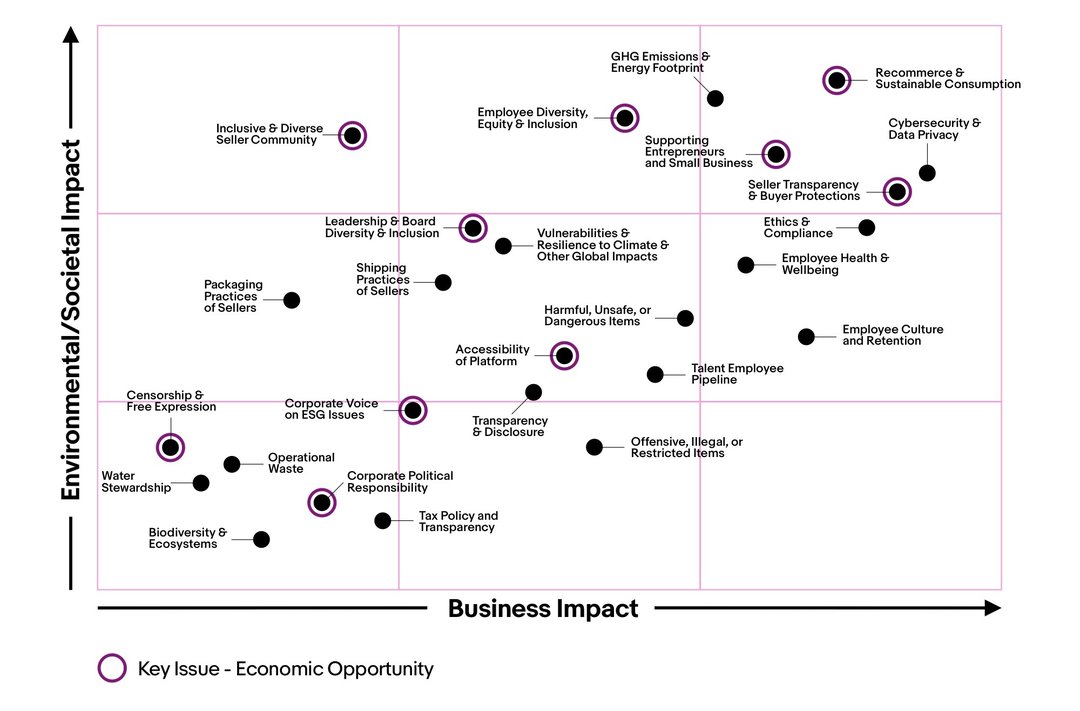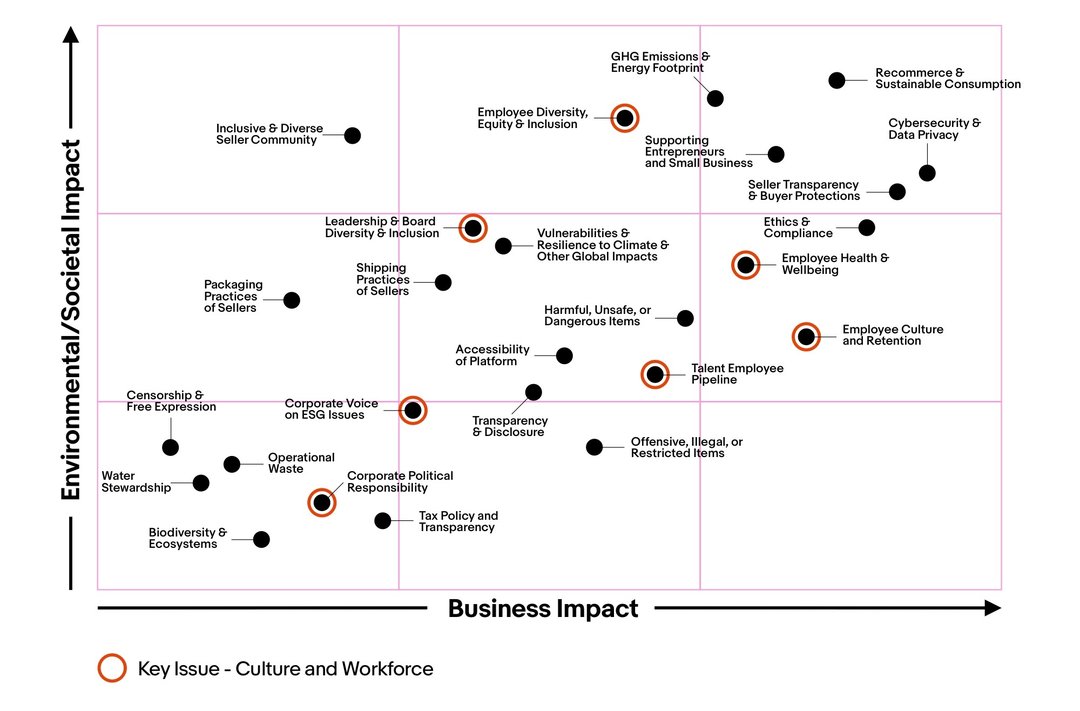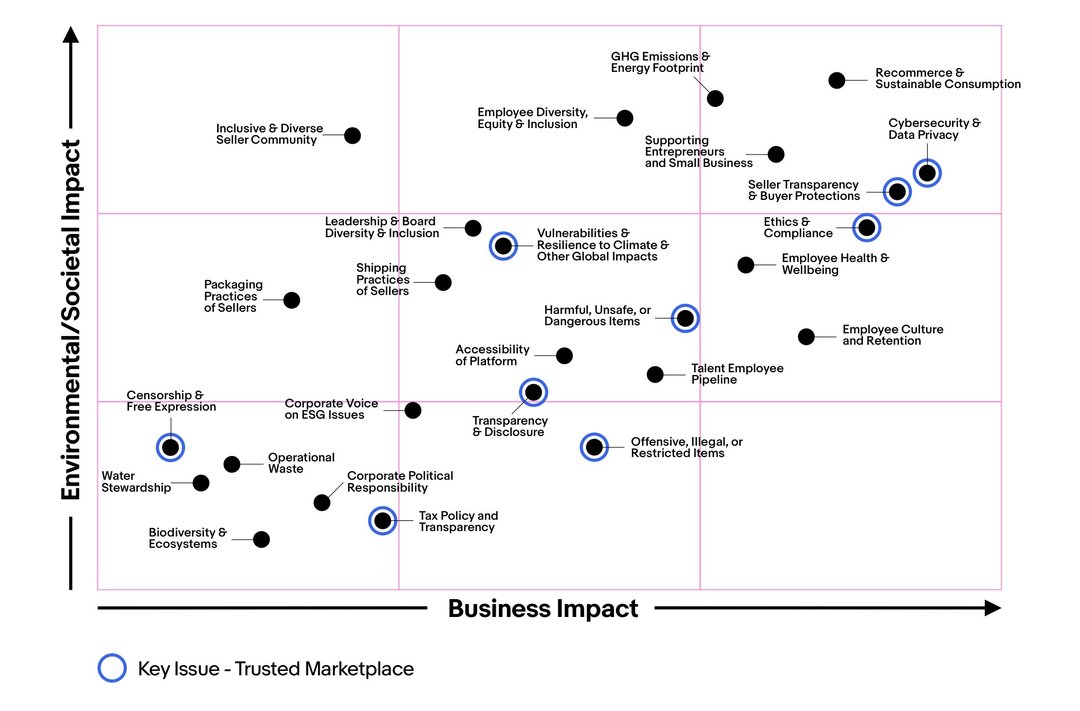Other: 2023 GRI and SASB Indices, 2023 ESG Independent Assurance Statements

IMPACT REPORT
IMPACT REPORT
We strive to lead the way for meaningful ecommerce.
We’re building a better future for our global community.

Creating a more sustainable future has been a cornerstone of eBay for more than 25 years. As longtime champions of recommerce and the circular economy, we are leading the way toward a healthier planet and a more inclusive economy.
I’m proud of the progress we are making on our climate goals and the positive impact this has on our planet. Today, eBay is leveraging new technologies more than ever to create trusted experiences for customers to sell and buy pre-loved goods.
Our team is committed to helping people make meaningful choices about how they shop and do business. Together, we are building a better future for our global community.
The possibilities are endless for how we will continue this important journey — for the benefit of our customers, our company, and our planet.

Download Our 2023 Impact Report Highlights
Impact at eBay
Explore our initiatives and programs.

Economic Opportunity
We empower entrepreneurs by providing them with access to a vast marketplace, allowing them to sell globally and grow locally — all while keeping their communities intact and thriving. Our business model is centered around inclusive entrepreneurship for everyone.

Sustainable Commerce
We strive to sustain the future of our customers, community, and planet. We track and quantify our environmental footprint while embracing recommerce and sustainable business practices, which allows us to continue to operate with integrity.

Culture and Workforce
We seek diverse perspectives, foster an inclusive work environment, and train our leaders to help each employee succeed at eBay based on their unique talents, contributions, and ambitions.

Trusted Marketplace
We shape our marketplace based on the strong ethical values we follow as a business: openness, honesty, integrity, and trust.
Issues Material to eBay
We partnered with GlobeScan, an independent research and advisory firm, in 2022 to update and expand our prior sustainability materiality assessment, prioritizing the most salient issues to sustainability and to our business.
The update included adjusting the matrix’s axes to incorporate impact outwards on the environment and society (y-axis) and impact inwards on our business and financial success (x-axis), incorporating additional data sources like external frameworks; environmental, social, and governance (ESG) ratings; consumer insights; and peer benchmarking. Input for this update involved a much larger variety of stakeholders, including eBay employees, external subject matter experts, relevant NGOs, and more. The results from this materiality update inform eBay’s sustainability strategy, initiatives, and goals. This report is focused on four key areas of our business: Economic Opportunity, Sustainable Commerce, Culture and Workforce, and Trusted Marketplace.
Sustainability Materiality Matrix
Supporting entrepreneurs and small businesses is a key focus area at the heart of eBay’s business. Other high-priority material issues include ensuring seller transparency and buyer protections.

About this chart: Economic Opportunity
This scatterplot illustrates sustainability issues material to eBay measured according to increasing business impact along the x-axis and increasing environmental and social impact along the y-axis. In this view, key issues related to economic opportunity are highlighted in purple. Key issues with a low impact on our business, environment, and society include censorship and free expression, corporate political responsibility, and corporate voice on ESG issues. Key issues with a medium impact on our business, environment, and society include leadership and board diversity and inclusion, accessibility of platform, and seller community diversity and inclusion. Key issues with a high impact on our business, environment, and society include employee diversity, equity, and inclusion; supporting entrepreneurs and small business; seller transparency and buyer protections; and recommerce and sustainable consumption.
Sustainability Materiality Matrix
Recommerce and sustainable consumption are key focus areas at the heart of eBay’s business. Other high-priority material issues include managing our greenhouse gas emissions and energy footprint.

About this chart: Sustainable Commerce
This scatterplot illustrates sustainability issues material to eBay measured according to increasing business impact along the x-axis and increasing environmental and social impact along the y-axis. In this view, key issues related to sustainable commerce are highlighted in green. Key issues with a low impact on our business, environment, and society include water stewardship, operational waste, biodiversity and ecosystems, corporate voice on ESG issues, and corporate political responsibility. Key issues with a medium impact on our business, environment, and society include packing and shipping practices of sellers; accessibility of platform; vulnerabilities and resilience to climate; and other global impacts. Key issues with a high impact on our business, environment, and society include greenhouse gas emissions and energy footprint; supporting entrepreneurs and small business; and recommerce and sustainable consumption.
Sustainability Materiality Matrix
High-priority material issues include promoting employee diversity, equity, and inclusion; supporting employee health and wellbeing; and cultivating a strong company culture and employee retention rate.

About this chart: Culture and Workforce
This scatterplot illustrates sustainability issues material to eBay measured according to increasing business impact along the x-axis and increasing environmental and social impact along the y-axis. In this view, key issues related to culture and workforce are highlighted in orange. Key issues with a low impact on our business, environment, and society include corporate political responsibility and corporate voice on ESG issues. Key issues with a medium impact on our business, environment, and society include leadership and board diversity and inclusion, and talent employee pipeline. Key issues with a high impact on our business, environment, and society include employee diversity, equity, and inclusion; employee health and wellbeing; and employee culture and retention.
Sustainability Materiality Matrix
High-priority material issues include promoting cybersecurity and data privacy, ensuring seller transparency and buyer protections, and upholding ethics and compliance in all that we do.

About this chart: Trusted Marketplace
This scatterplot illustrates sustainability issues material to eBay measured according to increasing business impact along the x-axis and increasing environmental and social impact along the y-axis. In this view, key issues related to trusted marketplace are highlighted in blue. Key issues with a low impact on our business, environment, and society include censorship and free expression as well as tax policy and transparency. Key issues with a medium impact on our business, environment, and society include transparency and disclosure; offensive, illegal or restricted items; harmful, unsafe or dangerous items; and vulnerability and resilience to climate; and other global impacts. Key issues with a high impact on our business, environment, and society include ethics and compliance; seller transparency and buyer protections; and cybersecurity and data privacy.
Our Impact Goals
We continuously evaluate our impact programs and priorities, and set targets to track our progress. Explore our 2025 and 2030 goals.
Seller Showcase
Meet inspiring sellers who bring our marketplace to life.
eBay for Charity
Our platform helps charitable organizations reach their fundraising goals, and allows our customers to support the causes that are important to them.
eBay Foundation
We partner with nonprofit organizations around the world to advance inclusive and equitable entrepreneurship for individuals and communities.
Recommerce
Through the buying and selling of pre-loved and refurbished goods, we create real change for the environment by extending the life of items and avoiding carbon emissions.
Supporting Sustainable Development
In addition to our 2025 impact goals, we support the United Nations Sustainable Development Goals (SDGs) through our platform, initiatives, and business operations. Below are six SDGs where we align our efforts.
Awards & Recognition
- TIME Magazine – Best Companies for Future Leaders 2024
- S&P Global – The Sustainability Yearbook
- Silicon Valley Business Journal – Top 100 Corporate Philanthropists
- CNBC/JUST Capital – JUST List
- Human Rights Campaign – Corporate Equality Index “Equality 100 Award”
- U.S. Environmental Protection Agency – Green Power Partnership









